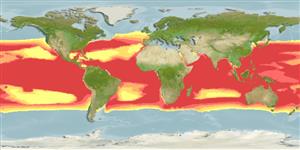Environment: milieu / climate zone / depth range / distribution range
Ecology
Marine; pelagic-oceanic; oceanodromous (Ref. 51243); depth range ? - 200 m (Ref. 86942). Subtropical
Worldwide in warm seas. Western Indian Ocean: including Reunion and Mauritius (Ref. 33390). Eastern Pacific: off San Francisco in California, USA to Chile, but rare north of Baja California in Mexico. Western Atlantic: Florida in USA and Gulf of Mexico to Brazil (Ref. 7251). Eastern Central Atlantic: St. Paul's Rocks (Ref. 13121).
Size / Weight / Age
Maturity: Lm ? range ? - ? cm
Max length : 30.0 cm SL male/unsexed; (Ref. 5288)
Host specific on manta rays, but occasionally attaches to sharks. Often occurs inside gill chamber and mouth of host. Also attaches itself to black marlin, Makaira indica, of the Indo-Pacific Region (Ref. 7251). Rarely free-swimming (Ref. 10791). Used in Chinese medicine (Ref. 12166).
Life cycle and mating behavior
Maturity | Reproduction | Spawning | Eggs | Fecundity | Larvae
Gray, K.N., J.R. McDowell, B.B. Collette and J.E. Graves, 2009. A molecular phylogeny of the remoras and their relatives. Bull. Mar. Sci. 84(2):183-198. (Ref. 86676)
IUCN Red List Status (Ref. 130435: Version 2024-1)
Threat to humans
Harmless
Human uses
Tools
Special reports
Download XML
Internet sources
Estimates based on models
Preferred temperature (Ref.
123201): 16.7 - 28.2, mean 25.7 °C (based on 1829 cells).
Phylogenetic diversity index (Ref.
82804): PD
50 = 0.5352 [Uniqueness, from 0.5 = low to 2.0 = high].
Bayesian length-weight: a=0.00257 (0.00110 - 0.00600), b=3.17 (2.96 - 3.38), in cm total length, based on LWR estimates for this (Sub)family-body shape (Ref.
93245).
Trophic level (Ref.
69278): 3.4 ±0.4 se; based on size and trophs of closest relatives
Resilience (Ref.
120179): Medium, minimum population doubling time 1.4 - 4.4 years (Assuming Fec < 10,000).
Fishing Vulnerability (Ref.
59153): Low to moderate vulnerability (27 of 100).
